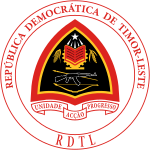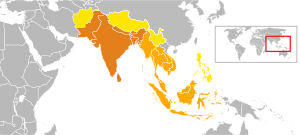Pre-colonial Timor
| History of East Timor |
|---|
 |
| Chronology |
|
| Topics |
|
|
Early history
The island of
Around 3000 BC, a second migration brought
The Timorese in their region
The later Timorese were not seafarers, rather they were land focused peoples who did not make contact with other islands and peoples by sea. Timor was part of a region of small islands with small populations of similarly land-focused peoples that now make up eastern Indonesia. Contact with the outside world was via networks of foreign seafaring traders from as far as China and India that served the archipelago. Outside products brought to the region included metal goods, rice, fine textiles, and coins exchanged for local spices, sandalwood, deer horn, bees' wax, and slaves.[5]
Indianised Hindu-Buddhist kingdoms (3rd century – 16th century)

Earlier Buddhist era (3rd century BCE – 7th century)
This section is empty. You can help by adding to it. (April 2020) |
Indianised Javanese Hindu-Buddhist Srivijaya empire (7th – 12th century)
Oral traditions of people of the
Relations with Indianised Javanese Hindu empire of Majapahit (12th – 16th century)
Majapahit empire's Nagarakretagama chronicles called Timor a tributary,[8] but as Portuguese chronologist Tomé Pires wrote in the sixteenth century, all islands east of Java were called "Timor".[9] Indonesian nationalist used the Majapahit chronicles to claim East Timor as part of Indonesia.[10]
Chiefdoms or polities
Early European explorers report that the island had a number of small chiefdoms or princedoms in the early sixteenth century. One of the most significant is the
The account of
Trade with China
Timor is mentioned in the thirteenth-century Chinese
Trade with the Philippines
Filipinos, known as Luções among Portuguese sailors, were recorded to have visited and settled in East Timor before Spanish colonization of the Philippines. The Magellan expedition recorded that when they anchored on the island, they witnessed Luções merchants who traded Philippine gold for East Timorese sandalwood.[15]
European colonisation and Christianisation (16th century onward)
Beginning in the early sixteenth century, European colonialists—the Dutch in the island's west, and Portuguese in the east—would divide the island, isolating the East Timorese from the histories of the surrounding archipelago.[8]
See also
References
- ISBN 962-593-076-0.
- ^ "Evidence of 42,000 year old deep sea fishing revealed : Archaeology News from Past Horizons". Archived from the original on 15 May 2013. Retrieved 6 September 2012.
- PMID 22116883.
- ^ Timor Leste History Archived 9 July 2007 at the Wayback Machine, official website.
- ^ ISBN 0-300-10518-5.
- OCLC 57054139.
- ^ H.J. Grijzen (1904), 'Mededeelingen omtrent Beloe of Midden-Timor', Verhandelingen van het Bataviaasch Genootschap 54, pp. 18–25.
- ^ ISBN 0-300-10518-5.
- ^ Population Settlements in East Timor and Indonesia Archived 2 February 1999 at the Wayback Machine – University of Coimbra
- ^ History of Timor Archived 24 March 2009 at the Wayback Machine – Technical University Lisbon (PDF-Datei; 805 kB)
- ^ Precolonial East Timor.
- ^ L. de Santa Catharina (1866), História de S. Domingos, Quatra parte. Lisboa: Panorama, p. 300.
- ^ James J. Fox (1982), 'The great lord rests at the centre: The paradox of powerlessness in European-Timorese relations, Canberra Anthropology 5:2, p. 22.
- .
- ^ The Mediterranean Connection By William Henry Scott (Published in "Philippine Studies" ran by Ateneo de Manila University Press)
